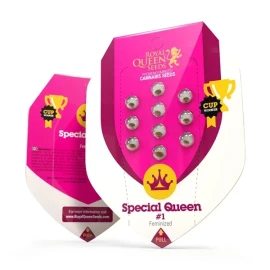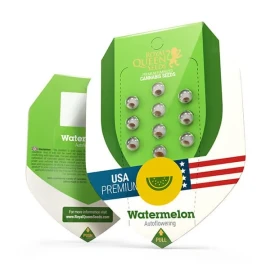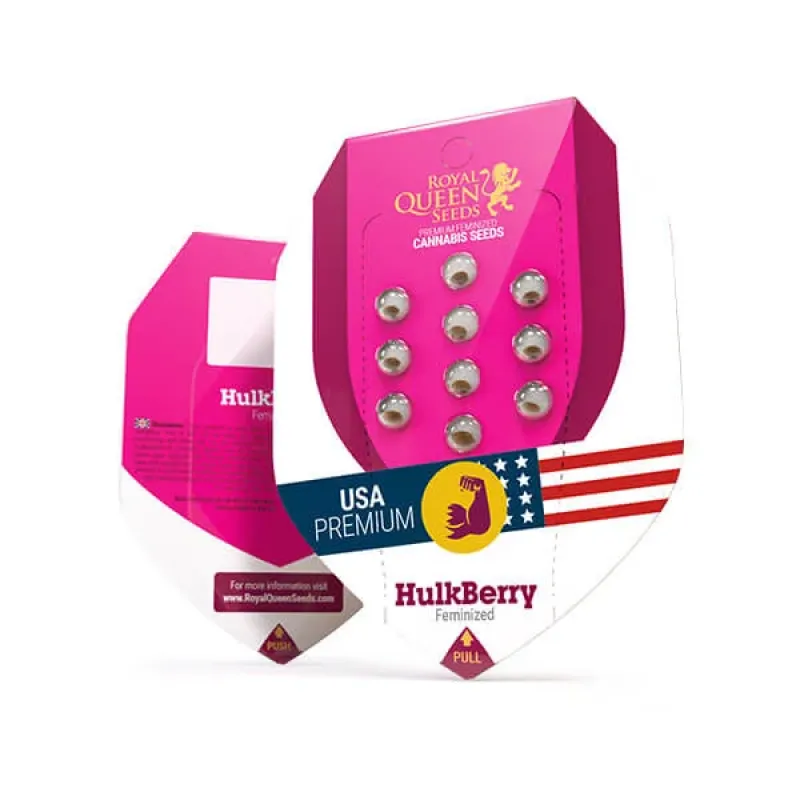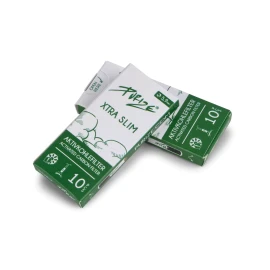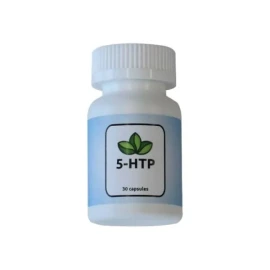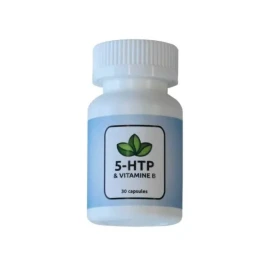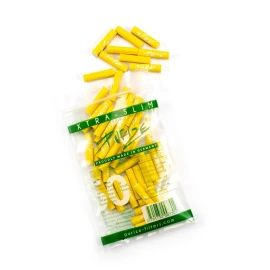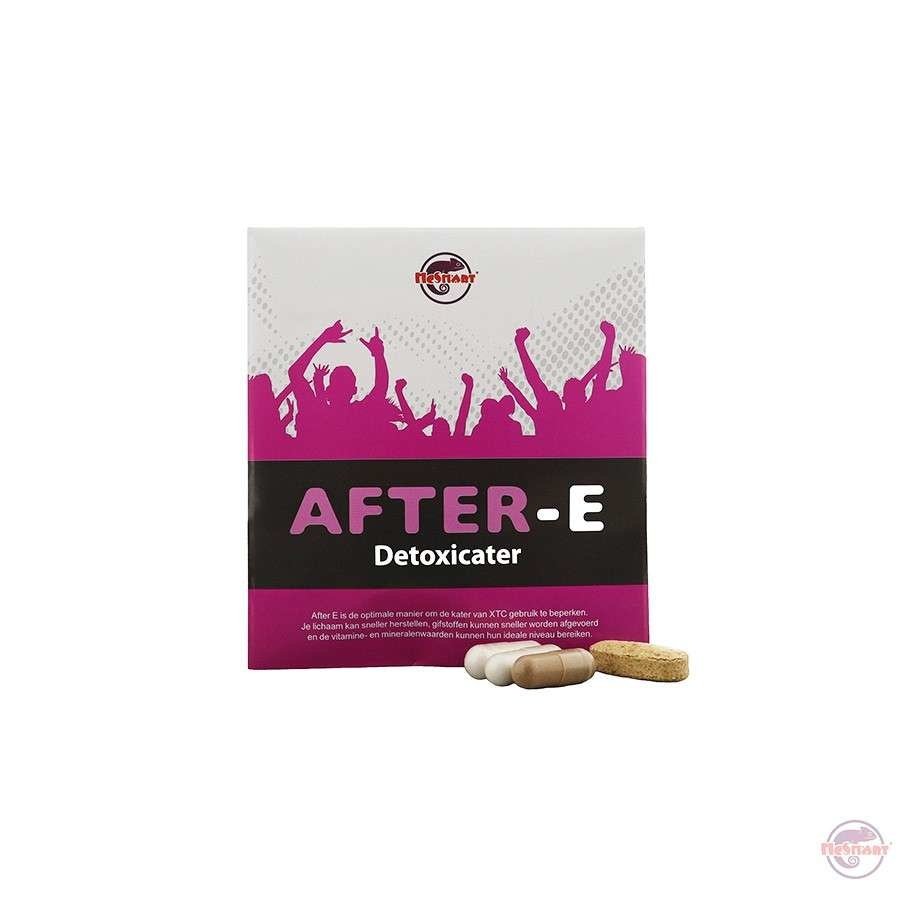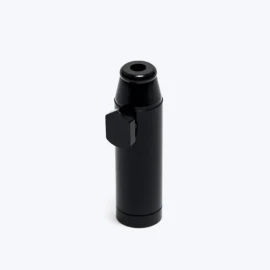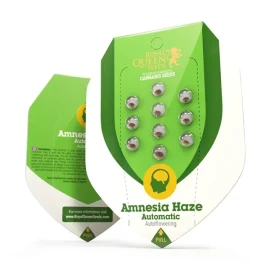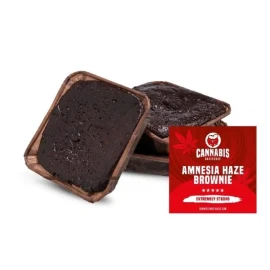Hulkberry
12,00 €
Hulkberry stands as one of the most potent sativa-dominant hybrids available, combining OG Kush and Strawberry Diesel genetics to create an exceptional strain delivering up to 28% THC. Originally exclusive to Colorado breeders, this powerhouse has gained global recognition for its intense cerebral effects and distinctive sweet-diesel flavor profile.
Quick Snapshot
Sativa-dominant hybrid delivering extreme THC potency with sweet strawberry and diesel aromatics, perfect for experienced users seeking powerful cerebral stimulation.
- Type: Sativa-dominant hybrid (feminized seeds)
- Genetics: OG Kush x Strawberry Diesel
- THC: 27-28.5% (very high) | CBD: ~0.5% (low)
- Major Terpenes: Limonene, Caryophyllene, Linalool
- Flowering Time: 9-10 weeks
- Indoor Yield: 400-450 g/m²
- Outdoor Yield: Up to 700 g/plant
- Best For: Experienced recreational users, mood enhancement, creative focus
Genetics & Lineage
Hulkberry’s exceptional potency stems from carefully selected parent genetics that each contribute distinct characteristics to the final product. The OG Kush parentage provides the strain’s legendary potency and heavy resin production, along with classic diesel and earthy undertones that form the backbone of the smoking experience. Meanwhile, Strawberry Diesel contributes the signature fruity aromatics and uplifting sativa traits that define Hulkberry’s cerebral nature.
This genetic combination places Hulkberry in the same family as Bruce Banner, sharing similar high-potency profiles and sometimes being compared to Bruce Banner #3 phenotypes. Breeders specifically created this cross to achieve maximum THC concentration while maintaining the distinctive fruit-diesel aroma that sets premium strains apart from standard offerings.
The genetic stability of Hulkberry allows for consistent phenotype expression, though growers should expect some variation in terpene profiles between individual plants. This variability actually benefits cultivators by providing opportunities to select phenotypes that best match their specific preferences for aroma, effect, or growing characteristics.
Appearance, Aroma & Flavor
Hulkberry flowers display classic sativa-influenced structure with elongated, moderately dense colas that showcase deep green coloration accented by vibrant orange pistils. Depending on phenotype and growing conditions, some plants may develop attractive purple hues during the final weeks of flowering, particularly when exposed to cooler nighttime temperatures.
The strain’s most striking visual characteristic is its exceptional trichome coverage, creating a crystalline coating that makes Hulkberry ideal for concentrate production. This heavy resin production not only contributes to potency but also preserves the complex terpene profile that defines the strain’s sensory experience.
Aroma Profile:
- Primary: Sweet strawberry, diesel fuel
- Secondary: Citrus zest, earthy undertones, floral notes
- Complexity: Multilayered progression from initial fruity sweetness to deeper diesel and earth finishing notes
The flavor experience mirrors the aromatic complexity, beginning with prominent strawberry sweetness on the inhale, transitioning through citrusy middle notes, and finishing with distinctive diesel characteristics that linger pleasantly on the palate. The well-preserved terpene profile ensures that properly cured Hulkberry maintains its full flavor spectrum throughout storage.
Potency & Cannabinoid Analysis
Hulkberry consistently ranks among the highest-THC strains available, with laboratory testing regularly confirming THC concentrations between 27-28.5%. This exceptional potency places it firmly in the “very high” category, requiring careful dosing consideration for all users, particularly those with limited cannabis experience.
Standard Cannabinoid Profile:
- THC: 27-28.5% (batch dependent)
- THCa: Variable based on curing and storage
- CBD: ~0.5% (minimal)
- CBG: Trace amounts typically <1%
Major Terpene Profile:
Limonene (Primary): Provides the citrus aromatics and contributes to mood elevation and stress reduction. This terpene also enhances the bioavailability of other cannabinoids, potentially intensifying overall effects.
Caryophyllene (Secondary): Delivers spicy, peppery notes while offering potential anti-inflammatory properties. This terpene uniquely interacts with CB2 receptors, potentially providing additional therapeutic benefits.
Linalool (Tertiary): Contributes floral undertones and calming properties that help balance the intense cerebral stimulation from high THC content.
Laboratory analysis reveals total terpene concentrations typically ranging from 2-4%, with significant batch-to-batch variation depending on growing conditions, harvest timing, and curing methods. Growers seeking maximum terpene preservation should focus on maintaining optimal environmental conditions throughout the growing cycle and implementing slow-drying techniques.
Effects, Consumption & Dosage
Hulkberry delivers powerful sativa-dominant effects characterized by intense euphoria, heightened creativity, and sustained mental energy. The onset typically occurs within 5-15 minutes of consumption, with peak effects lasting 2-4 hours and gradual tapering over an additional 2-3 hours.
Primary Effects:
- Intense cerebral stimulation and euphoria
- Enhanced creativity and focus
- Elevated mood and sociability
- Increased energy and motivation
- Heightened sensory perception
Recommended Applications:
- Recreational: Social gatherings, creative projects, daytime activities for experienced users
- Wellness: Mood support, motivation enhancement, appetite stimulation
- Note: Limited CBD content reduces traditional medical applications
Dosage Considerations:
Due to extremely high THC content, conservative dosing proves essential, especially for users with moderate tolerance levels. New users should begin with minimal amounts and wait at least 30-45 minutes before considering additional consumption. The intense potency can easily overwhelm unprepared users, leading to anxiety or uncomfortable psychoactive effects.
Potential Side Effects:
- Dry mouth and eyes (common)
- Increased appetite
- Possible dizziness or anxiety in sensitive users
- Potential for orthostatic hypotension
Users should avoid combining Hulkberry with alcohol or other substances, and should not operate vehicles or machinery after consumption. The long-lasting effects require planning for extended periods of impairment.
Complete Growing Guide
Seed Selection & Phenotype Considerations
Hulkberry is primarily available as feminized seeds from established seed banks, ensuring female plants and eliminating the need for early sexing. While clones offer faster starts and phenotype predictability, seeds provide genetic diversity and the opportunity to select superior mother plants for future propagation.
Growers should expect phenotype variation primarily in terpene expression, with some plants favoring strawberry aromatics while others emphasize diesel characteristics. Advanced cultivators often germinate multiple seeds to identify phenotypes that match their specific preferences for aroma, potency, or growing traits.
Growing Environment Setup
Indoor Cultivation:
Hulkberry thrives in controlled indoor environments where height management becomes crucial due to significant sativa stretch during early flowering. Recommended setup includes:
- Space Requirements: Minimum 6-foot ceiling height to accommodate stretch
- Lighting: Full-spectrum LED or HPS, 600-1000 watts per 4×4 area
- Ventilation: Strong exhaust system with carbon filtration for odor control
- Container Size: 3-5 gallon pots for optimal root development
Outdoor Cultivation:
Outdoor plants can achieve impressive sizes with yields up to 700 grams per plant under optimal conditions. Success requires:
- Climate: Mediterranean or similar warm, dry climate
- Security: Tall, visible plants require discrete location
- Harvest Timing: Late September to mid-October in Northern Hemisphere
- Support: Sturdy stakes or cages for heavy branches
Training & Canopy Management
Hulkberry responds exceptionally well to training techniques that control height while maximizing yield potential:
Low Stress Training (LST): Begin during vegetative growth to create horizontal canopy development. Gently bend main stem and secure to container edges, encouraging lateral growth and multiple main colas.
Topping: Remove apical dominance by cutting main stem above 4th-6th node during vegetative growth. This creates multiple main branches and reduces overall height while increasing yield sites.
SCROG (Screen of Green): Install screen at 12-18 inches above container level. Train branches through screen openings during vegetative growth, then allow vertical growth during flowering while maintaining even canopy height.
SOG (Sea of Green): Use numerous smaller plants (9-16 per square meter) with minimal vegetative time. This method maximizes space efficiency and reduces total grow time.
Detailed Growing Timeline
Germination & Seedling (Week 1-2):
- Maintain 75-80°F temperatures with high humidity
- Provide gentle lighting (fluorescent or low-power LED)
- Keep soil consistently moist but not waterlogged
Vegetative Growth (Week 3-8):
- Increase lighting to 18-24 hours daily
- Maintain temperatures 70-80°F with 50-60% humidity
- Begin LST or topping during week 4-5
- Feed balanced nutrients with higher nitrogen content
- Monitor for healthy green growth and strong stem development
Pre-Flowering Transition (Week 9):
- Switch to 12/12 light cycle to initiate flowering
- Reduce nitrogen while increasing phosphorus and potassium
- Expect significant stretch during first 2-3 weeks
- Continue training to manage height and distribute light
Flowering Development (Week 10-17):
- Maintain 65-75°F temperatures with 40-50% humidity
- Monitor trichome development with magnification
- Reduce humidity to 30-40% during final weeks
- Flush with plain water during final 7-10 days
Harvest Timing (Week 18-19):
- Observe trichomes for cloudy appearance with some amber
- Check for brown pistils (70-90% changed color)
- Harvest when trichomes show desired maturity level
Nutrient Management
Hulkberry performs best with moderate feeding schedules that preserve terpene development while supporting vigorous growth:
Vegetative Nutrition:
- Base NPK ratio: 3-1-2 for healthy leaf development
- Cal-Mag supplementation in hydroponic systems
- pH maintenance: 6.0-6.8 in soil, 5.5-6.2 in hydro
- Monitor for nitrogen deficiency in lower leaves
Flowering Nutrition:
- Transition to 1-3-2 NPK ratio during early flowering
- Increase phosphorus for bud development
- Reduce nitrogen to prevent delayed maturation
- Add bloom boosters during weeks 4-6 of flowering
Common Feeding Issues:
- Overfeeding: Burns leaf tips and reduces terpene quality
- Underfeeding: Premature yellowing and reduced yields
- pH Fluctuation: Nutrient lockout and deficiency symptoms
Environmental Control
Temperature Management:
- Day: 72-82°F (22-28°C) optimal range
- Night: 65-75°F (18-24°C) for proper metabolism
- Avoid temperature swings exceeding 10°F
- Monitor for heat stress during peak lighting periods
Humidity Control:
- Vegetative: 50-60% RH promotes healthy growth
- Early Flowering: 45-55% RH prevents mold while supporting development
- Late Flowering: 35-45% RH crucial for preventing bud rot
- Air circulation essential for humidity management
Lighting Considerations:
- Vegetative: 18-24 hours daily, moderate intensity
- Flowering: 12 hours daily, high intensity
- Light stress symptoms: bleaching, stunted growth
- Heat stress from lights: leaf curling, yellowing
Pest & Disease Prevention
Hulkberry shows moderate resistance to common cannabis pests and diseases but requires preventive care:
Common Threats:
- Spider mites in hot, dry conditions
- Thrips during vegetative growth
- Powdery mildew in humid conditions
- Bud rot during late flowering
Prevention Strategies:
- Maintain proper environmental conditions
- Regular inspection for early detection
- Beneficial insects for biological control
- Organic preventive sprays during vegetative growth
- Avoid foliar treatments during flowering
Advanced Cultivation Techniques
SOG Implementation:
- Use 4-9 plants per square meter
- Minimal vegetative time (2-3 weeks)
- Focus on single main cola development
- Requires consistent phenotypes for even canopy
SCROG Setup:
- Install screen 12-18 inches above containers
- Fill screen 75% during vegetative growth
- Allow vertical growth during flowering
- Provides excellent light distribution and support
Hydroponic Considerations:
- Faster growth and higher yields possible
- Requires precise nutrient and pH management
- DWC or flood-and-drain systems work well
- Monitor root health and water temperature
Phenotype Variations & Selection
Hulkberry exhibits several distinct phenotypes that differ primarily in terpene expression and plant structure. Understanding these variations helps growers select plants that match their specific goals:
Strawberry-Dominant Phenotype:
- Pronounced fruity aromatics
- Slightly shorter stature
- Earlier flowering tendency
- Higher limonene content
Diesel-Dominant Phenotype:
- Strong fuel aromatics
- Taller growth pattern
- Extended flowering period
- Higher caryophyllene expression
Balanced Phenotype:
- Equal strawberry and diesel characteristics
- Moderate height and flowering time
- Well-rounded terpene profile
- Most common expression
Experienced cultivators often maintain multiple phenotypes to provide variety in their harvests. Clone selection from seed-grown plants allows preservation of superior genetics for future grows.
Strain Comparisons
Hulkberry vs Bruce Banner:
Both strains deliver exceptional THC levels and powerful cerebral effects, but key differences distinguish them. Hulkberry typically provides more pronounced fruity aromatics from its Strawberry Diesel genetics, while Bruce Banner tends toward earthier, more diesel-forward profiles. Hulkberry often shows more sativa-influenced growth patterns, while Bruce Banner phenotypes may be more indica-leaning in structure.
Hulkberry vs Strawberry Diesel:
As a parent strain, Strawberry Diesel shares the fruity characteristics but typically shows lower THC concentrations (18-22% vs 27-28%). Hulkberry’s OG Kush genetics contribute significantly more resin production and potency while maintaining the signature strawberry aromatics that make both strains appealing.
Hulkberry vs OG Kush:
OG Kush provides the potency foundation for Hulkberry but differs significantly in effect profile. While OG Kush typically produces more relaxing, body-focused effects, Hulkberry’s sativa dominance creates energizing, cerebral stimulation. The strawberry components in Hulkberry also create a more complex flavor profile compared to OG Kush’s classic diesel and earth characteristics.
Troubleshooting Common Issues
Excessive Stretch During Flowering:
- Reduce distance between light cycles
- Implement LST or SCROG earlier
- Consider topping later in vegetative growth
- Monitor environmental temperature
Slow Vegetative Growth:
- Check root health and container drainage
- Verify pH levels in growing medium
- Assess nitrogen availability
- Ensure adequate lighting intensity
Bud Rot Prevention:
- Maintain humidity below 45% during late flowering
- Improve air circulation around plants
- Remove affected material immediately
- Consider preventive organic fungicides
Hermaphrodite Development:
- Identify and remove stress sources
- Monitor lighting schedules for interruptions
- Check environmental stability
- Remove hermaphrodite plants to prevent pollination
Harvest & Post-Harvest Processing
Proper harvest timing maximizes both potency and terpene preservation. Monitor trichomes with 60x magnification, looking for cloudy appearance with 10-20% amber coloration for peak THC content. Earlier harvest (fewer amber trichomes) emphasizes cerebral effects, while later harvest increases body relaxation.
Drying Process:
- Maintain 60-65°F temperature with 45-55% humidity
- Ensure adequate air circulation without direct airflow on buds
- Expect 7-14 days for complete drying
- Test stem snap for dryness indicator
Curing Recommendations:
- Use glass jars filled 75% capacity
- Burp daily for first week, then weekly
- Maintain 58-62% humidity with humidity packs
- Cure minimum 2-4 weeks for optimal quality
- Expect continued improvement for 2-3 months
Properly cured Hulkberry maintains its complex terpene profile and smooth smoking characteristics while preserving maximum potency. Temperature and humidity control during curing significantly impact final product quality.
Market Availability & Considerations
Hulkberry seeds are available through established seed banks in regions where legal cultivation is permitted. Pricing typically ranges from moderate to premium depending on breeder reputation, seed count, and regional availability. The strain’s popularity among concentrate producers and high-THC enthusiasts maintains consistent demand.
Typical Availability:
- Feminized seeds most common format
- Regular seeds occasionally available
- Clone availability varies by region
- Growing popularity in legal markets
Quality Considerations:
- Source seeds from reputable breeders
- Verify germination guarantees
- Check recent lab testing when available
- Consider shipping restrictions in your region
Legal Considerations
Cannabis cultivation laws vary significantly by jurisdiction. Before purchasing seeds or beginning cultivation, research local and regional regulations regarding plant counts, possession limits, and cultivation restrictions. Many areas require licenses or permits for legal cultivation, while others prohibit growing entirely.
Important Reminders:
- Check local cultivation laws before proceeding
- Understand plant count limitations in your area
- Verify seed purchasing legality in your jurisdiction
- Consider neighbor relations and local ordinances
- Maintain compliance with all applicable regulations
This information is provided for educational purposes only and does not constitute legal advice. Always consult local authorities or legal professionals regarding cannabis cultivation laws in your specific location.
Frequently Asked Questions
How strong is Hulkberry?
Hulkberry ranks among the most potent strains available, typically testing between 27-28.5% THC. This extreme potency requires careful dosing and is best suited for experienced users with established tolerance levels.
Is Hulkberry indica or sativa?
Hulkberry is a sativa-dominant hybrid combining OG Kush and Strawberry Diesel genetics. The sativa dominance creates energizing, cerebral effects rather than sedating body relaxation.
How long does Hulkberry take to flower?
Hulkberry typically completes flowering in 9-10 weeks under optimal growing conditions. Some phenotypes may require up to 11 weeks for full maturation and maximum terpene development.
What terpenes give Hulkberry its flavor?
The primary terpenes include limonene (citrus, mood elevation), caryophyllene (spicy, anti-inflammatory), and linalool (floral, calming). These combine to create the distinctive strawberry-diesel flavor profile.
Can beginners grow Hulkberry?
Hulkberry is not recommended for novice growers due to its height management requirements and specific environmental needs. Intermediate to advanced cultivators achieve the best results with this strain.
Does Hulkberry produce heavy yields?
Yes, Hulkberry can produce substantial yields when grown properly. Indoor cultivation typically yields 400-450 grams per square meter, while outdoor plants can produce up to 700 grams under optimal conditions.
Are Hulkberry seeds feminized?
Most commercial Hulkberry seeds are sold as feminized, eliminating male plants and ensuring efficient use of growing space. Regular seeds are occasionally available for breeding projects.
What are the medical benefits of Hulkberry?
While primarily recreational, Hulkberry may support mood enhancement, motivation, and appetite stimulation. The low CBD content limits traditional medical applications compared to balanced ratio strains.
How should Hulkberry be cured for best aroma?
Slow drying at 60-65°F with 45-55% humidity, followed by jar curing with daily burping for the first week, preserves maximum terpene content. Proper curing enhances both flavor and smoothness.
What makes Hulkberry different from other high-THC strains?
Hulkberry’s unique combination of extreme potency with complex strawberry-diesel terpenes distinguishes it from other high-THC varieties. The sativa-dominant effects provide energy and creativity rather than sedation.
Related Products
Frequently Asked Questions
Everything You Need to Know

